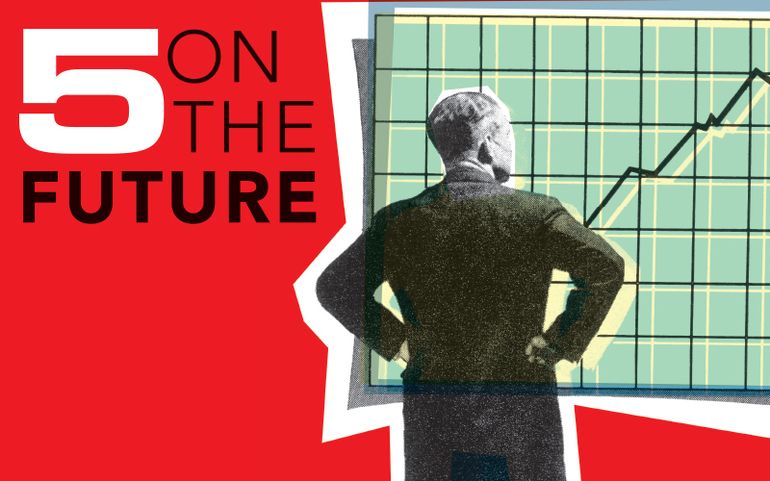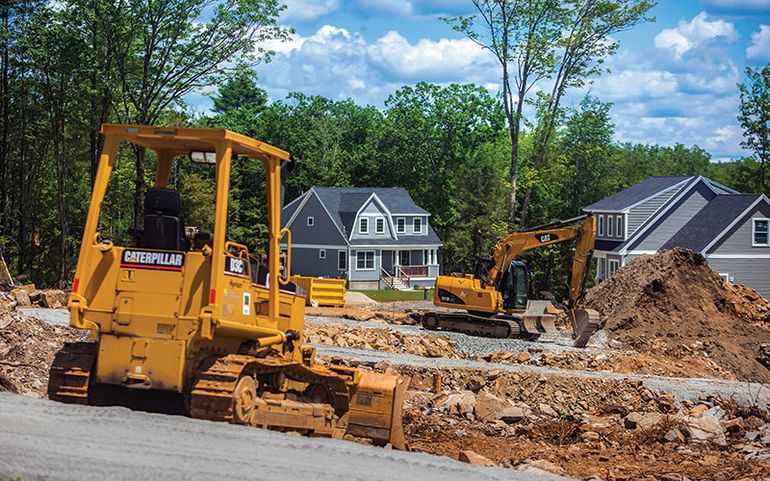Processing Your Payment
Please do not leave this page until complete. This can take a few moments.
- News
-
Editions
View Digital Editions
Biweekly Issues
- December 1, 2025
- Nov. 17, 2025
- November 03, 2025
- October 20, 2025
- October 6, 2025
- September 22, 2025
- + More
Special Editions
- Lists
- Viewpoints
-
Our Events
Event Info
Award Honorees
- Calendar
- Biz Marketplace
Five experts offer their take on the outlook for Maine's economy in 2018

 Catherine Reilly deLutio: Former Maine state economist, Catherine a partner at 45 North Research. This is her first time contributing to Five on the Future.
Catherine Reilly deLutio: Former Maine state economist, Catherine a partner at 45 North Research. This is her first time contributing to Five on the Future.
 Jim Damicis: Senior vice president at Camoin Associates, Jim is also contributing to Five on the Future for the first time.
Jim Damicis: Senior vice president at Camoin Associates, Jim is also contributing to Five on the Future for the first time.
 Stefan K. Iris: A chartered financial analyst and chief investment officer at Camden National Wealth Management, Stefan is contributing to Five on the Future for the first time.
Stefan K. Iris: A chartered financial analyst and chief investment officer at Camden National Wealth Management, Stefan is contributing to Five on the Future for the first time.
 Amanda Rector: Current Maine state economist and a longtime contributor to Five on the Future.
Amanda Rector: Current Maine state economist and a longtime contributor to Five on the Future.
 Rachel Bouvier: A private consultant and economist at RBouvier Consulting, Rachel is contributing to Five on the Future for her second time.
Rachel Bouvier: A private consultant and economist at RBouvier Consulting, Rachel is contributing to Five on the Future for her second time.
 Photo / Tim Greenway
Construction and development is a bright spot in Maine’s economy, but it’s tempered by a shortage of qualified workers.
Photo / Tim Greenway
Construction and development is a bright spot in Maine’s economy, but it’s tempered by a shortage of qualified workers.
Heading into 2018, it's clear that predicting the economic future is a risky endeavor. Global politics, jittery financial markets, rising interest rates, shifting policies — all can create chaos for the economy. Maine is often among the first to experience an economic downturn and among the last to recover. With that in mind, we asked five experts — a few economists, an investment adviser and a public policy analyst — their outlook for the Maine economy in 2018. Some of the themes may have a familiar ring, including the historically low unemployment rate and the need for qualified workers. But some of what they said might surprise you.
This year's five experts are:
Catherine Reilly deLutio, a former Maine state economist and a partner at 45 North Research.
Jim Damicis, senior vice president at Camoin Associates.
Stefan K. Iris, a chartered financial analyst and chief investment officer at Camden National Wealth Management.
Amanda Rector, Maine state economist.
Rachel Bouvier, a private consultant and economist at RBouvier Consulting.
1. What are some areas of growth in Maine?
DeLutio: Tourism is doing very well. Every year seems to bring a new visitation record and savvy businesses are expanding into higher-margin products and services. As a result, since 2010, the output of Maine's accommodation and food services industry has grown three times faster than the rest of the economy (6.7% average annual GDP growth versus 2.2%). Looking geographically, Greater Portland is clearly Maine's urban economic engine. Since 2010, more than half (58%) of employment growth has occurred in the Portland-South Portland metro area, which encompasses parts of Cumberland, York and Androscoggin counties.
Damicis: Health care is growing as demand increases, driven by an aging population, technology and service delivery advances and further integration with retail and distributed service delivery. Maine continues to grow around its thriving food economy, driven by its resources and quality brand. This includes everything from local agriculture, fishing, food processing, specialty food production and breweries, as well as its rapidly growing and nationally recognized restaurant scene. Maine will continue to experience the transformation occurring globally around the “tech of everything” as digital technologies infiltrate and disrupt all sectors and create new opportunities in “heathtech,” “fintech,” “agtech,” manufacturing industry 4.0 and the Internet of Things, as well as other sectors.
Iris: There are several areas that may potentially drive growth in Maine in 2018. Given state demographics, health care and elder care demand will likely increase as the baby boomer generation ages, with life expectancies trending longer over the long term. Local food-and-beverage specialties are a perennial tourism draw, aided by growth of cruise-ship landings. Business services and technology are additional potential areas of growth. On the technology front, the state has a leadership position in the animal health sector, which should continue to drive growth.
Rector: Maine saw another strong year for tourism in 2017, as favorable weather conditions and low gasoline prices coincided with continued economic growth. Lodging sales, which are closely tied to the tourism sector, likely broke $1 billion for the first time in 2017. Breweries and distilleries continue to expand across the state, with growth in some related agricultural areas as manufacturers look to source locally grown hops, malts and grains. The greater Portland area has seen both robust growth in commercial real estate and continued expansion of the International Marine Terminal, which provides new opportunities for Maine products to reach international markets.
Bouvier: Maine has great potential in renewable energy, aquaculture, local foods and ecotourism. All these industries rely on investments in natural capital, such as clean air and water, as well as incentives for the environmentally responsible use of natural resources. We need to encourage responsible economic development, but not at the expense of the quality of life of current and future Mainers.
2. What effect could tax reform have on the economy?
DeLutio: Our federal and state tax systems would both benefit from serious, comprehensive reform. Good reform would simplify the system so businesses and individuals can devote more resources to production rather than compliance and tax dodging. Good reform would improve our fiscal position by reducing deficits and unfunded liabilities, both of which hurt long-term growth; it would address both taxes and spending. Good reform would remove market-distorting loopholes and policies to encourage investment equally in both physical and human capital. And, just to be perfectly clear, tax cuts and tax increases alone are not the same as tax reform.
Damicis: The short-term effect will include an uptick in investment and even wages as the economy responds to the tax reform as a stimulus. This will be in addition to a certain level of a taking of profits by corporations from a portion of the economic gains. Mid-to- long-term, the tax reform will have a drag on economic growth as the deficit increases and significant cuts kick-in to programs that support infrastructure, health-care and workforce creating a further erosion of the middle class and increasing economic disparity.
Iris: The impact of tax reform on the economy is multi-faceted and nuanced. The current administration's pro-business emphasis may support growth from a supply-side perspective, which can ultimately fuel growth if tax savings are productively reinvested in capital spending and wage growth — key factors that are yet to be determined by business owners and leaders.
Rector: Nationally, there is the potential for increased economic activity in 2018. Early indications are that corporations will see a sizeable benefit, which could motivate some of Maine's many pass-through businesses to convert to C-corps, although pass-throughs themselves will see some additional tax benefits. Many individuals who have previously itemized will likely take the now-higher standard deduction instead. While Gov. Paul LePage has made considerable reductions to the income tax rates, Maine's top rate remains above the national average and so there may be some high-income taxpayers who might consider relocating if Maine doesn't continue to reduce taxes.
Bouvier: The administration claims that the corporate tax cut will stimulate the economy, through “trickle down” economics. That assumption is not borne out by past experience. Moreover, while the cuts to the taxes paid by corporations are permanent, the tax cuts to individuals will expire. Ultimately, the package exacerbates inequality and increases the federal deficit.
3. What impact could any new state legislation have on businesses?
DeLutio: The Pine Tree Development Zone program will expire at the end of 2018 unless the Legislature renews it. This is one of the state's core business incentive programs and a recent report called for modifying certain aspects of its design. How the Legislature handles that will affect future business development. The Legislature must also address the Medicaid expansion approved by voters in November. This outcome is particularly important for some rural hospitals that depend heavily on Medicaid reimbursements and are the largest employers in their communities. Similarly, the marijuana industry awaits the legalization that was approved by voters in 2016. Other potential issues include solar power regulation, broadband investment and changing the process for citizen-led referenda.
Damicis: The biggest legislative impacts in the coming year will not be on new programs, regulations and services but how Maine handles its budget and fiscal policy. Significant needs exist to support economic and workforce development around infrastructure, health care and education — all of which are critical to the economic well-being of Maine. Without adequate investment in areas through bonding and other means, Maine will be ill-prepared to compete in a global economy.
Iris: Legislators can attempt to stimulate economic growth either through deregulation or through tax reform. Regulatory improvements and fundamental reform could potentially bolster commercial and industrial projects on an expedited basis. The impact of legislation to reduce or eliminate state income tax is reliant on a subsequent surge in growth to offset state revenue loss. If growth falls short or does not flow through to increased tax remittances, then the state would be forced to make cuts in order to comply with its constitutional budget mandate.
Rector: By and large, the effects from the two most significant changes — Medicaid expansion and adult recreational marijuana — won't really be felt until 2019. In both cases, the details are still being worked out and there is the potential for additional implications from federal crackdowns on the marijuana issue. In order to limit the negative impacts from Medicaid expansion, the Legislature will need to come up with a responsible, ongoing funding source that doesn't jeopardize the state's fiscal position or result in a less hospitable environment for Maine businesses and residents. Additionally, the state will have to decide whether to conform to some or all of the federal tax reform changes, which could have a major impact on businesses.
Bouvier: Several bills that were carried over could have a huge impact on economic development. The most important ones are acts to develop a long-term plan for economic development, and efforts to improve public transportation and to fix our crumbling infrastructure. These bills will not come cheap, but they could have a huge positive impact on the work force and business development.
4. What are some of the biggest challenges and opportunities ahead?
DeLutio: Our biggest opportunity is turning some of the millions people who visit Maine each year into residents and lifelong consumers of Maine products. Every out-of-state visitor is like someone stepping into our showroom. Few other states have such a unique opportunity. If global instability continues in the long-run, Maine's safe communities, clean environment and scenic beauty will become ever more attractive and valuable. Some analysts see the next wave of global growth happening not in crowded megacities like New York but in smaller cities like Portland. Maine can prepare to leverage these trends by increasing our connections to outside economies — through telecommunications investments and business partnerships — and by welcoming new residents. Our biggest challenge is demographics — the wave of baby boomers nearing retirement and the lack of young people waiting to take their place.
Damicis: In Maine, challenges are most acute around workforce, infrastructure and public consensus. Maine is relatively old and continues to age as population and in-migration continue to lag. This will make filling job openings challenging for both new jobs created as well as replacement jobs. With a labor force participation rate around 63%, Maine will have to both attract more working-age population as well as support programs to enable more of its existing population, many of whom have personal barriers, to enter and remain in the workforce. Maine also has considerable challenges related to infrastructure with significant needs for upgrading, maintaining, and creating new infrastructure. This includes transportation, telecommunications and energy infrastructure. These challenges for Maine are not only financial, but also political. Politically, this plays out as a clear lack of public consensus on the value of economic development and what it takes to make it occur. Far too many projects take far too long to come to fruition. Many are thwarted by NIMBYism, lack of consensus and lack of leadership.
Iris: The biggest challenge can also be seen as an opportunity as we look ahead to 2018 and beyond. Maine is the oldest state in the country with a median age of 44 years, according to the U.S. Census Bureau, with little prospect of moving toward a more youthful demographic in the near term. This challenge may be offset by the opportunity for increased growth in the health care industry — albeit with an increased burden of paying for an aging population. Another opportunity and additional offset to the challenges presented by an aged population is the growing number of out-of-state students enrolling in the University of Maine system. An increase in the number of educated young people coming into the state will ultimately fuel economic growth — especially if they find jobs and remain in the state after graduation.
Rector: The single most important challenge facing the state is Maine's demographic situation. More and more businesses in the state are facing the realities of an aging workforce and lack of population growth. This challenge must be overcome for the state to continue to grow. On a positive note, the 2017 Census Bureau population estimates had stronger growth for Maine, based on higher numbers of people moving to the state. Interest in local, sustainable and artisanal food and beverages continues to grow. Maine is becoming more vertically integrated around these sectors, which is exciting. You can take raw goods grown or harvested in Maine, add value through an in-state production process and then ship them around the world.
Bouvier: Maine faces difficult choices on how it will choose to grow and what it will do to support that growth. Maine spends about 1% of its GSP on research and development. That is not enough. We need to tie R&D efforts to areas where Maine needs more qualified workers. Several things that could help, as already mentioned, are to increase strategic investments in infrastructure, education and broadband. Finally, and obviously, we face an ongoing opioid epidemic and the aging of Maine's population. As to the first, we need to ensure increased access to treatment and rehabilitation for those affected. For the second issue, we need to implement policies that allow for folks to age in place: affordable elderly housing, public transportation and expansion of Medicare. However, the aging of Maine's workforce is also an opportunity. There is a wealth of knowledge and experience in those workers. We need to ensure that those skills are not lost in the transition to a younger generation, by encouraging mentorships and on-the-job training.
5. How can Maine increase its labor pool?
DeLutio: By encouraging more baby boomers to stay in the workforce past 65, helping disengaged workers, especially prime-age males, gain the skills employers need, welcoming more immigrants and turning more tourists into residents. According to the Maine Office of Tourism, 26 million out-of-staters visited Maine last summer. If just one-quarter of 1% of them moved here, that would be 65,000 people — that's another Portland.
Damicis: Maine can increase its pool of talent by working with communities and developers for the development of a variety of types of affordable workforce housing, including rental and ownership, as affordability continues to decline in the nations' job centers. This can be combined with public investment in Maine's downtowns, main streets and village centers to support the lifestyle and amenities desired by the work force and entrepreneurs. Maine can also continue to support and grow it entrepreneurial ecosystems and supporting people “creating jobs” as opposed to “getting a job.” Finally, Maine can make a big shift in education and workforce by investing in mandatory five-year high schools with attainment of associate's degrees and/or job readiness and certifications combined with robust apprenticeship programs through partnerships among high schools, community colleges and employers.
Iris: One way Maine can increase its pool of workers is by the continued success of the University of Maine system in attracting out-of-state enrollments. Innovation driven by a younger educated work force combined with an increase in training programs for older workers — administered by private business or at various community college campuses — could further serve to provide in-demand skills to increase the worker pool.
Rector: There is no single, simple solution to the workforce shortage problem. Instead, it takes a coordinated and sustained effort from both the private and public sectors. Maine's private-sector employment has reached a record high, indicating that some progress is already being made. Continuing to engage those workers already here is one of the short-term fixes — keeping older workers on the job, retraining the long-term unemployed, and seeking out underemployed workers. Longer term, we need to attract more workers to the state. Policy changes are one way to address this, such as student loan debt relief and a competitive income tax structure. Private companies can also think about innovative ways to entice more young workers from out of state.
Bouvier: We need to welcome with open arms those who come to Maine from different states or even different regions of the world. Apart from the southern regions of the state, natural population growth—births minus deaths — is negative. If we want to increase our labor force, we need to encourage and promote in-migration. Finally, remember that the labor force includes all those who are actively looking for a job, as well as those who are currently employed. Maine has a very low unemployment rate, but that doesn't include discouraged workers or those who are underemployed. We need to support those who are willing and able to work, yet might need re-training or education to get a new or better job.
Mainebiz web partners

The Giving Guide
The Giving Guide helps nonprofits have the opportunity to showcase and differentiate their organizations so that businesses better understand how they can contribute to a nonprofit’s mission and work.
Learn More
Work for ME
Work for ME is a workforce development tool to help Maine’s employers target Maine’s emerging workforce. Work for ME highlights each industry, its impact on Maine’s economy, the jobs available to entry-level workers, the training and education needed to get a career started.
Learn More
Groundbreaking Maine
Whether you’re a developer, financer, architect, or industry enthusiast, Groundbreaking Maine is crafted to be your go-to source for valuable insights in Maine’s real estate and construction community.
Learn more-
The Giving Guide
The Giving Guide helps nonprofits have the opportunity to showcase and differentiate their organizations so that businesses better understand how they can contribute to a nonprofit’s mission and work.
-
Work for ME
Work for ME is a workforce development tool to help Maine’s employers target Maine’s emerging workforce. Work for ME highlights each industry, its impact on Maine’s economy, the jobs available to entry-level workers, the training and education needed to get a career started.
-
Groundbreaking Maine
Whether you’re a developer, financer, architect, or industry enthusiast, Groundbreaking Maine is crafted to be your go-to source for valuable insights in Maine’s real estate and construction community.
ABOUT
NEW ENGLAND BUSINESS MEDIA SITES
No articles left
Get access now
In order to use this feature, we need some information from you. You can also login or register for a free account.
By clicking submit you are agreeing to our cookie usage and Privacy Policy
Already have an account? Login
Already have an account? Login
Want to create an account? Register
Get access now
In order to use this feature, we need some information from you. You can also login or register for a free account.
By clicking submit you are agreeing to our cookie usage and Privacy Policy
Already have an account? Login
Already have an account? Login
Want to create an account? Register







Comments